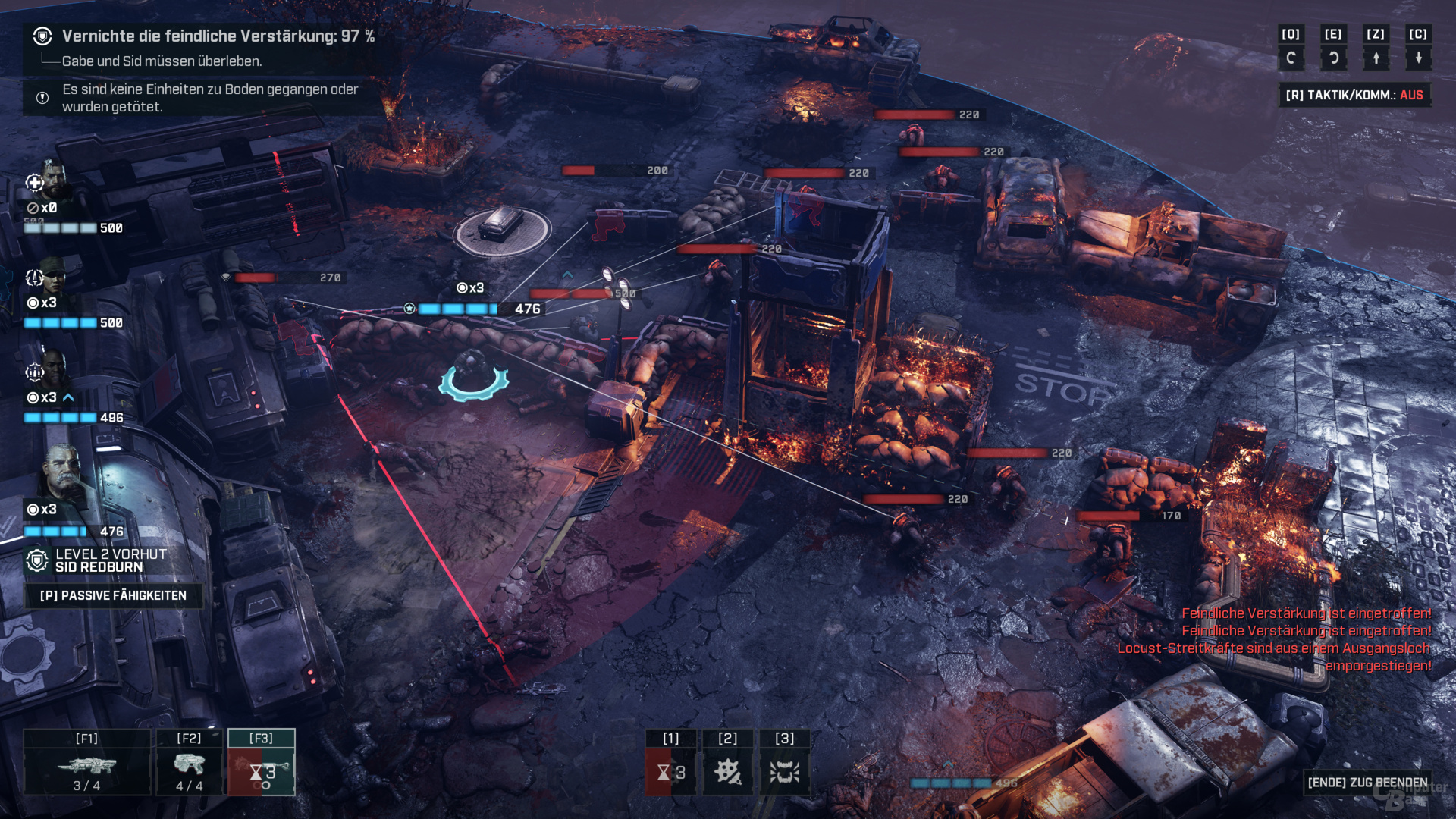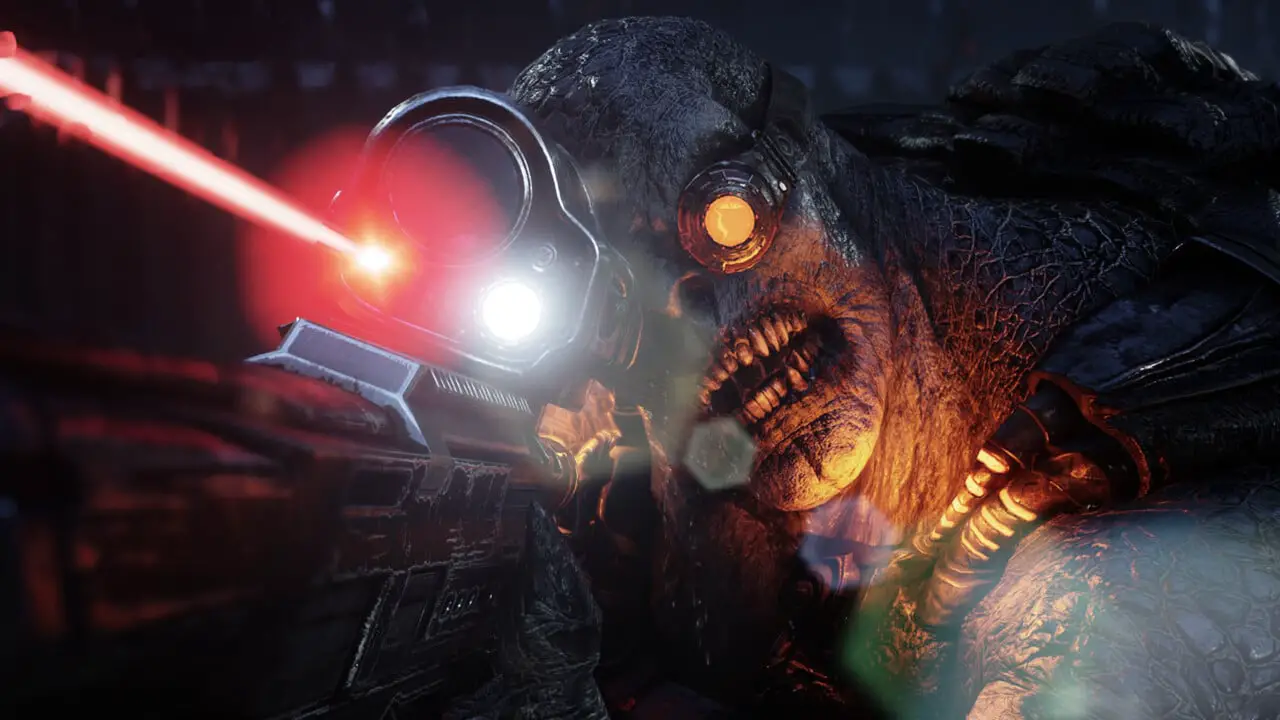Gears Tactics (PC) im Technik-Test
: Test |CUP | Specs |Config
tl;dr: After Gears 5 there is no Gears 6, but Gears Tactics. The well-known action series turns into a round strategy game that has not forgotten its roots: Gears Tactics is also extremely brutal and technically well implemented. The graphics are of a high standard and offer a lot of interesting things.
Update 04/29/2020 1:49 p.m.
April 2020 offers real highlights for fans of round strategy: After the spin-off XCOM: Chimera Squad (test) that appeared out of nowhere, Gears Tactics is an offshoot from the well-known Gears universe.
Round strategy at Gears follows XCOM
While XCOM: Chimera Squad is technically launching a savings program as a bridge to XCOM 3, Gears Tactics is going all out as an initially PC-exclusive game. The game optically borrows a lot from its big brother Gears 5 (test), even if there are big differences due to the camera perspective alone. But that doesn’t change the fact that Gears Tactics not only looks good for a round strategy game, but also in general.
It starts with the many high-quality cut scenes and ends with the harmonious lighting and the chic shadows. The animations and textures are good, there are nice looking particle effects and there is always something going on on the screen. The well-known chainsaw with its liquid simulation also looks great, but also suggests: Round strategy or not, Gears Tactics, like its big brothers, is very brutal.
In order to achieve the high optical quality, developers Splash Damage and The Coalition rely on the same technical framework as with Gears 5 and thus the Unreal Engine 4. However, unlike almost all representatives of its kind, Gears Tactics only uses the low-level API DirectX 12 – luckily again as a Win 32 application and not as an unspeakable UWP app, regardless of whether the game is bought in the Microsoft Store or on Steam.
Eine Premiere: Variable Rate Shading
Gears Tactics offers a completely new feature on the PC, which is also part of DirectX 12 Ultimate. This is not about ray tracing, but about variable rate shading, which is supposed to enable better performance on Nvidia’s Turing graphics cards with hardly any visual quality or not at all. The technology test clarifies whether this succeeds and how, among other things, Async Compute affects performance.
Gears 5 already offers an excellent graphics menu and Gears Tactics is in no way inferior. Quite the opposite, because in addition to descriptions of the individual options, there are now sample screenshots that Gears 5 is still missing. In addition, each menu item lists whether it affects the CPU, GPU performance or the memory consumption of the graphics card.
The game offers two FPS limiters. A normal one that can be configured to 30, 60, 90, 120 or 144 FPS. And a second one that only comes into play in the numerous in-game cutscenes. However, it does not offer more than “off” or “30 FPS”. Your own downsampling and upsampling is of course included, the internal resolution can be freely set between 33 and 200 percent. Alternatively, there is also a dynamic resolution. A frame rate must be set there (30, 60 or 90 FPS) and the game then tries to use the resolution as a variable to ensure that it does not fall below this value.
The Gears Tactics graphics menu
image 1 of 5
But that’s not all. There is an overlay that can either only show the frame rate or other information such as the frame times. The effect of the numerous common graphics options can be tested with an integrated benchmark. Even if this may hardly play a role after the one-time setting, the graphics menu of Gears Tactics is absolutely exemplary. Every game can and should learn a big slice of this.
Four graphic presets with big differences
Gears Tactics offers four different graphic presets with “Low”, “Medium”, “High” and “Ultra”. Ultra is not quite the maximum, however, because the “high-gloss reflections” option can still be activated manually.
If you leave out the high-gloss reflections, you don’t have to do without a lot of graphic quality. Only a few surfaces are covered by this at all and then the differences are small. However, it looks completely different with the four presets, here the optical losses are large with each individual step.

Maximum details
image 1 of 5
The volumetric fog was deactivated for the screenshots, because the images can be better compared this way.
Even with the high preset, Gears Tactics looks a lot worse, because all fire and glow effects are massively reduced, which visibly costs atmosphere. In addition, the shadows are significantly softer, while others are completely absent and the level of detail is generally reduced for some objects. For optical reasons, you should avoid reducing the graphic details even further.
Because from the medium preset onwards, the game is simply no longer nice. Many shadows and the surrounding obscuration disappear completely, the textures become blurred and some objects are not even displayed. On low the whole thing happens again, only much more effectively. Gears Tactics goes from a really nice game to a really ugly one.
The tuning potential is very large
The maximum level of detail does not look much good and does not cost too much performance. If you switch back to the ultra preset, a GeForce RTX 2070 Super only accelerates by seven, a Radeon RX 5700 XT by only eleven percent. The high preset then looks a lot worse, but it also brings a lot more: on the Nvidia graphics card, the plus is 37 percent, on the AMD counterpart 24 percent. So Nvidia wins more power than AMD.
Graphics presets – 2,560 × 1,440
Low preset
Medium preset
High preset
Ultra-Preset
Maximum details
Low preset
Medium preset
High preset
Ultra-Preset
Maximum details
This balances out with the medium preset, because with this the GeForce is 59 percent faster, while the Radeon is 71 percent faster. The middle preset already more than doubles the performance of Gears Tactics.
The anti-aliasing works properly
Gears Tactics offers decent anti-aliasing. In low resolutions such as 1,920 × 1,080 not all objects are smoothed well and there is a slight blurring over the image. But that hardly bothers and does not play a role from 2,560 × 1,440. In addition, the game offers a sharpness function that can be used to swap the calm image for sharpness – or vice versa.
A graphics card with 6 GB is sufficient
Gears Tactics doesn’t have very detailed textures, which is not necessary for a round strategy game. You can’t get too close to objects anyway and the surfaces are equipped with absolutely sufficient details for the camera perspective that is usually used.
Even if graphics cards in Ultra HD address almost 8 GB of memory at the maximum level of detail, the game reports that only 6 GB are required. This is also suggested by the test series, because 8 GB no longer brings any advantages over 6 GB in the game. A graphics card with 4 GB is sufficient for 1,920 × 1,080; from 2,560 × 1,440 it should be 6 GB.
On the next page: DirectX 12 with VRS, GPU, CPU benchmarks and frame times















